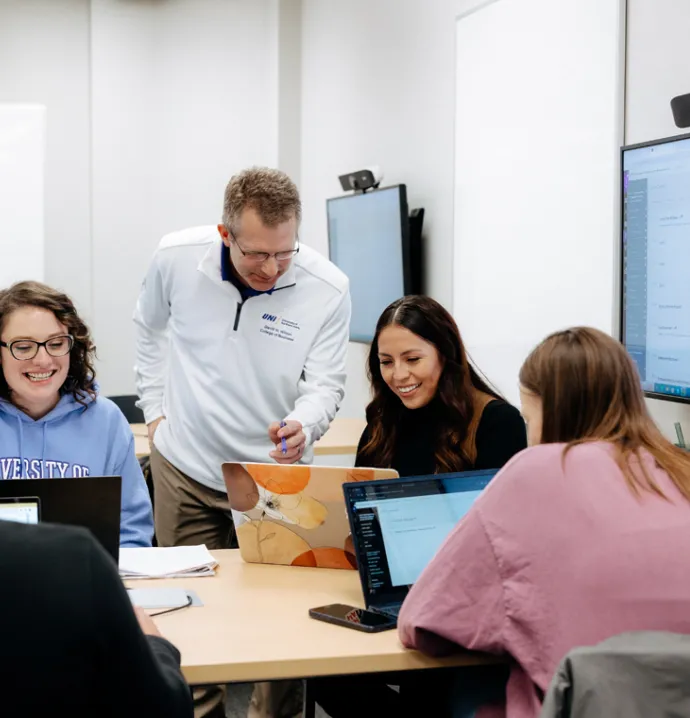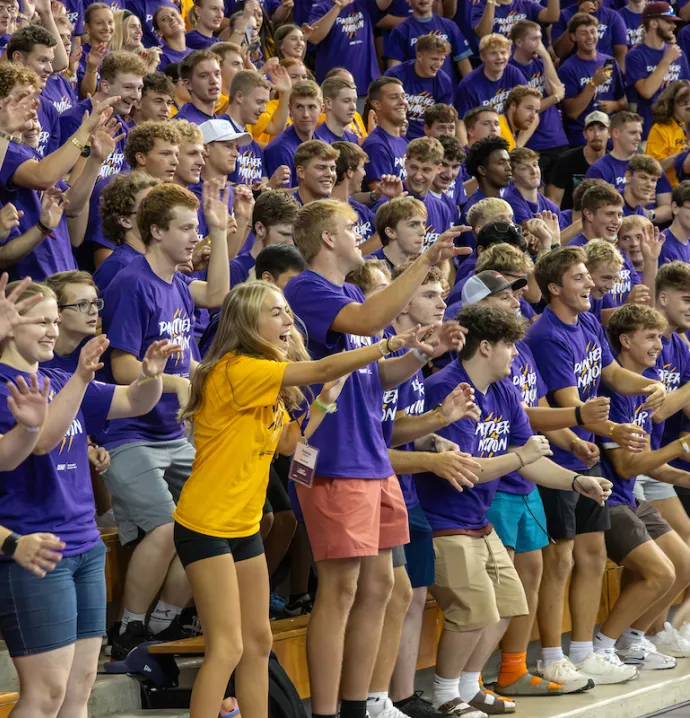UNI professors talk technology, communication and coronavirus
UNI professors talk technology, communication and coronavirus
The COVID-19 pandemic has forced many of us to move our social lives online, which can make a major impact on our real-life relationships. Here, UNI communications faculty Lori Johnson and Sarina Chen join psychology professor Helen Harton to discuss how communication and technology are changing — and changing us — in the era of social distancing.
With so many of us in quarantine, almost all of our communication has shifted online. What impact does this have on our relationships?
Johnson: I think there’s obviously some pros and cons. The pros are that it’s motivated people to reach out to old friends or even family that you don’t get to talk to or connect with very often. And … we’ve put more effort into that connection. As great as technology is, it doesn’t do everything for us. Zoom is definitely not the same as being face to face. Just the lag time between people trying to ask questions and interact in a bigger group is trickier.
I think that another thing that we lack through all of this is the physical human connection. We lack sitting and being in close proximity with others; we lack being able to touch each other, whether that’s a hug or holding hands or just putting your arm around somebody. No matter what the context of the relationship is, that lack of physical connection is very hard on us. We all need physical touch to some degree.
Harton: Being on social media, and especially depending on what type you're on, what types of programs you’re using, can have impacts on people because you’re not getting as personal of a connection. We have some connection that you lose with online communication. It’s not as real as real life is. You don’t have the same rhythm of conversation as you do in a regular conversation. A lot of the time people aren’t looking at each other even in video conference calls, because they’re looking at their screen.
Chen: Video conferencing is not face-to-face communication. Sight and sound signals were compressed, some distortions are generated. The sound sounds like a person, the images look like a person, but they are not the exact person you have communicated with face to face. The excitement about Zoom is not too different from the excitement about the cell phone. Zoom and other video modes of communication will slowly blend in our social life ... as users become more experienced with them, and have a better understanding of the utilities of the tool, and how to best use them, not over use them.
Some cell phone providers have reported an increase in voice calls in the months following the COVID-19 pandemic. Is there a difference between voice communication via telephone and video chatting on apps like Zoom? What about text messaging apps? What are the pros and cons of each communication tool?
Harton: I think one of the nice things about phone calls, and one of the reasons why that seems by some reports to have increased, is you get to have a natural conversation with someone. So you've got that natural pause, you can hear whether the person is saying something in a sarcastic way, or in a joking way or friendly way. You get a lot more information when you can hear their vocal cues even if you can't see them, as opposed to text messages, which are really easy to be misunderstood, to be taken in the wrong way, and they don't provide a lot of context. One of the reasons why you get so much nasty back and forth on Facebook is that people don't get those cues that they would normally get face to face.
Johnson: Not everybody is comfortable being seen on a FaceTime or Zoom call. Different generations have different comfort levels with just talking on the phone compared to . For example my 75 year old mom will only FaceTime or Zoom if it’s planned … so she’s much more comfortable just talking on the phone. She feels like she has to have this presentation about her … she needs to have her hair done and her makeup on. It has to be more planned. Whereas my daughters, who are in their 20s, they’ll just FaceTime in any given moment.
Chen: Text messaging, voice messaging, and video messaging all come with their unique advantages and disadvantages. Users need to evaluate these advantages and disadvantages when choosing the most useful channel of communication for their tasks at hand. Text messaging of all kinds allows you to provide detailed and specific information, although it does not have much emotional element. Audio form of communication has an emotional element, and also is good for rapidfire negotiations. Video conferencing provides the most satisfying tool of communication for loved ones where the content of communication is not vital, while the emotional needs are the major concerns. When seeing grandpa is important, not listening to grandpa’s incoherent sentences, you use Zoom.
Some experts have said that video chatting can actually make people feel more anxious and isolated than just voice chat. Is there a reason for this? There’s also the concept of “Zoom burnout,” which leaves people feeling exhausted from constant video chatting. Is there a way to video chat or communicate virtually without running into these issues?
Johnson: [Zoom burnout] is happening with students, with people who work from home full-time. Myself, along with other professionals I know, as well as friends, have become pretty intentional with how we schedule our days. We’re trying to find other ways to have a meeting without having to do Zoom all the time. Being intentional about scheduling your Zoom meetings is one way to avoid burnout [as well as] keeping your Zoom meetings or appointments to a time frame and letting people know up front how much time you have.
Harton: I think another reason people get anxious with the Zoom conversations is also that some people feel like there's a lot more focus on them because it's looking at your face. So a lot of people get very self conscious in those types of conversations as well. It takes a lot more energy for us to monitor in a Zoom environment, because you've got 20 separate pictures that you're trying to look at and trying to monitor. You can't tell if people are listening to you or not listening to you. We have these visceral reactions, to feeling like people are ignoring us.
Chen: Users who are disappointed by video chatting, may be because they compare the video mode to face-to-face communication, and hence are disappointed when they do so. One needs to know that there is simply no comparison. Video chat is a TV dinner, while face-to-face communication is a home-cooked meal. Zoom’s daily active users jumped from 10 million to 200 million in 3 months. Zoom may be overused, people use Zoom when there is no need for that or when other modes of communication may be more suitable. As users have more experiences with video conferencing and more understanding of the utilities of the tool, the excitement should die down over time.
In addition to Zoom burnout, many people are feeling overwhelmed from the abundance of communication happening at this time — in addition to Zoom, constant email and social media notifications on our phones, a never-ending news cycle, and pressure to be available for work communications at all times. How does this impact our relationships and ourselves?
Harton: [Quarantine] puts you in a situation where work and home are kind of together. And it's harder to separate those out. That, along with all the news and all of the stress and all this ... in psychology, we call it a cognitive load. There are all these things to think about and stress about, and it just makes it more difficult to monitor ourselves and to keep ourselves from saying things that we wouldn’t normally say or reacting to others in a negative way.
Johnson: I love reading the news and … it’s a pro and a con in that we have access to news all the time. It infiltrates into our relationships. Obviously it affects us and however it is affecting us, we take that into other relationships. So if we’re feeling very anxious and worried about this, we might then share that with somebody else as just a way of connecting with them, but then maybe get them upset or get them feeling more anxious. We have to be cautious there in terms of what we ingest informationally.
We [also] have to really be good about drawing the line when it’s work time when it’s time to stop and play, or to exercise, or fix a good meal, or just to sit and be. You have to know what your own needs are. As humans, we all crave some level of routine because that’s what gives us stability. We need that so we can be productive people and be healthy mentally, but also so we can be good relational partners to other people. When that routine gets messed up or broken or some way or changed, it can leave us feeling a little off kilter or fleeting, and I think that’s where people start to struggle. When you don’t carve out that time also to fulfill your own personal needs, it can affect our relationships with others.
Chen: This pandemic is new, so is the communication surrounding the pandemic. This pandemic caused adjustments in lifestyles which include communication channels and behaviors. I am always optimistic about the users’ abilities to adjust and to make changes due to the circumstances they are in. My optimism has led me to a successful career examining how people creatively utilized communication technologies for their own needs. Give people/users time, they will adjust.
Do you have any advice for people about how to best communicate virtually? What about how to balance virtual communication with other needs as well as our real-life connections?
Johnson: Understand and realize that people place different values on different modes of communication. It’s important to understand that whoever it is that you’re communicating with, what mode of communication is most important to them or what is the way that they communicate the best? It’s good to ask somebody, ‘Do you want to FaceTime or would you want to wait and talk to tomorrow?’ We often don't take the time to ask, especially the people that were the closest to. We just make a lot of assumptions.
Harton: I think one of the things that happens as this has gone on is it's been this long term anxiety that people have had and that kind of makes them withdraw. So encouraging people to think about ways that they can connect with others. You don't have to just be isolated. You don't have to just use Zoom — you may be able to call a friend. Try to have some face-to-face interactions where you can, or phone interactions, or other interactions that are a little more ‘real,’ so you’re not just relying only on technology. Think about what you can do to connect to others, rather than focusing on all the things that you can't do. And probably reading the news less… more news leads to more anxiety. When we hear about bad things happening, it makes us feel like they’re more prevalent than they actually are.
Chen: Technology is a liberation, a liberation from constraints, spatial or temporal. We use technologies when we could not communicate face to face. Technologies are extensions of users’ senses, allowing users to bond, when they are outside of each other’s immediate presence. Users use technologies, and are not used by technologies. If we keep users and their social life centered, overuse of a technology can be avoided. Some selections need to be made — whom and what to communicate, and using what channels. When everyone is video chatting, that does not mean that I need to join in as well. Users will learn to select based on the company they have, and the type of information they need. I am confident an equilibrium will be achieved.




